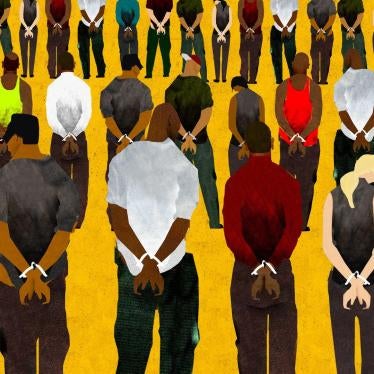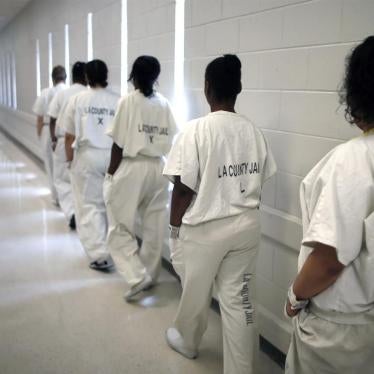Ellen F. Rosenblum, Attorney General
Oregon Department of Justice
1162 Court Street, NE
Salem, OR 97301-4096
March 29, 2021
Sent via email and FedEx
Dear Attorney General Rosenblum:
Human Rights Watch urges you to withdraw your opposition to retroactive application of the decision in Ramos v. Louisiana,[1] finding non-unanimous jury convictions unconstitutional. We ask that you agree to reverse all convictions resulting from known non-unanimous juries, including those whose appeals have been heard and rejected. This action is consistent with your duty as a prosecutor to treat all who come before you fairly and to do justice.
Human Rights Watch is an international organization with staff in more than 40 countries, including the United States, which works to defend the rights of people worldwide. We investigate abuses, expose the facts related to those abuses, and advocate that those with power respect rights and secure justice. Failure to reverse convictions obtained by discriminatory non-unanimous juries simply because of the timing of those convictions would be an arbitrary application of law and inconsistent with international human rights standards requiring states to eliminate racial discrimination, including structural discrimination.[2]
Discriminatory non-unanimous juries violate international human rights law and undermine the integrity of Oregon Courts.
On May 6, 2019, Aaron Knott, the legislative director of the Oregon Office of the Attorney General, presumably at your direction, wrote to the Chair of the House Committee on Rules in support of HJR 10, an Oregon bill asking voters to approve requiring unanimous juries.[3] He said, “Requiring unanimous juries ensures fair representation, promotes systemic accountability and legitimacy, and brings Oregon in line with all 49 of our sister states.”[4] He linked the existing law to racial disparities in the application of justice in the state and to the exclusion of minority voices.
The following year, the US Supreme Court held that convictions by non-unanimous juries are unconstitutional.[5] That ruling mandates unanimous juries for all future cases and requires reversing non-unanimous verdicts still on appeal. While it does not require reversal of cases whose appeals are final, principles of fairness and international human rights law do.
The International Convention on the Elimination of All Forms of Racial Discrimination (ICERD), which the United States has ratified, guarantees the right to equal treatment and protection under law, without discrimination along racial and other lines.[6] It prohibits policies and practices that have the purpose or the effect of restricting rights based on race, including facially race neutral practices that create racial disparities.[7] Governments are obligated to act affirmatively to end practices with discriminatory impacts.[8] They also have an obligation to provide effective remedies for violations of human rights, including racial discrimination.[9] The state of Oregon has an obligation to remedy the racially discriminatory impact of its non-unanimous jury rule.
As Mr. Knott pointed out, this discriminatory rule’s exclusion of diverse viewpoints has impacted the administration of justice in Oregon for decades. Any criminal conviction based on a discriminatory system risks being a false conviction, undermines the courts and justice system, and is a wrong that should be corrected. Mr. Knott’s concern for the integrity of the legal system does not only apply to those people convicted recently who have not exhausted their appeals; it applies to everyone convicted under an unfair system.
Non-unanimous jury laws were motivated by racial and ethnic bias and continue to discriminate.
Voters in Oregon approved the non-unanimous jury rule by ballot initiative in 1934. The arguments in favor of the measure in the election voter pamphlet highlighted that rights, like the “reasonable doubt” standard, the requirement of judicial neutrality, and the right to remain silent, hampered the prosecution so greatly that non-unanimous juries were necessary for efficient processing of convictions.[10] The proponents claimed the rule would save taxpayers the expense of retrials in cases of deadlocked juries and would relieve court congestion.
They also made reference in this ballot statement to the high-profile case, People v. Silverman, in which one juror disagreed with the majority and prevented conviction for murder. The newspaper, The Oregonian, was more explicit about the anti-Semitic and nativist overtones of the ballot measure, referring to immigrants from southern and eastern Europe being unfit for jury service.[11] You have acknowledged the discriminatory intent of Oregon’s non-unanimous jury rule.[12]
A study of 2014 incarceration data in Multnomah County, Oregon’s most populous, by the MacArthur Foundation Safety and Justice Challenge, found that Black people are incarcerated at a rate more than six times greater than white people, and Native Americans at a rate almost twice that of white people.[13] The Ramos Project, at Lewis &Clark Law School, has found that while making up only 2.2 percent of the state’s population, Black people, at the time of Ramos ruling, were 16 percent of those convicted by non-unanimous juries.[14]
Underrepresentation of non-white people on juries has been a persistent and systemic problem in Oregon and throughout the United States.[15] An American Bar Association report states: “Either way, a system in which non-diverse juries are almost uniformly deciding the fate of minority criminal defendants is inherently contrary to our society’s professed dedication to achieving and maintaining equality.”[16] A 1994 study on racial and ethnic bias in Oregon’s court system found that jury pools did not reflect community diversity, instead over-representing white people.[17] It found that peremptory challenges were used to remove minority jurors and that exclusion impacted deliberations and perceptions of fairness.[18] In his 2019 memo to the Chair of the House Committee on Rules supporting HJR 10, Knott said that maintaining representative diversity in Oregon jury pools was a “continuing challenge.”[19]
While it would be inaccurate to blame racially disparate incarceration levels entirely on non-unanimous juries, they are certainly a contributing factor, marginalizing the viewpoints of the few non-white people who serve on juries.
This inequity has existed in Oregon courts for decades. While the Ramos ruling forbids future harmful application of the rule, the state should still take action to correct past injustices by allowing people convicted under an unfair and discriminatory system an opportunity to re-litigate their cases under a lawful one. Refusal to do so would perpetuate the old system’s discriminatory impact.
Denial of equal rights for decades outweighs concerns about court efficiency.
People tried under the non-unanimous jury rule remain in prison when they otherwise might have avoided conviction. Those already released still have criminal records that impact their ability to find work and housing, to access public benefits, and to obtain professional licenses. They carry a stigma that, under a fair, non-discriminatory system, they may never have had.
Following the Ramos decision, your office released a statement calling it “good news,” the end of “an embarrassment” to the state, indicating that you were “well-prepared to address its significant consequences.”[20] The statement expressed confidence that the Oregon bench and bar would cooperate to address all the cases impacted by this decision.
However, by refusing to give those convicted under the non-unanimous jury rule who have completed their appeal an opportunity to reverse their conviction, you are arbitrarily deciding that some people’s rights are too burdensome to honor.
No doubt, reviewing all applicable convictions, reversing those obtained by an unfair and discriminatory system, and resolving those cases through new trials, plea agreements, and dismissals will be more work for the prosecutors, defense lawyers, and the courts than limiting yourselves to those pending or with unfinished appeals. The Federal Public Defender has submitted an amicus brief in the Edwards v. Vannoy case presenting data showing that the number of cases is not overwhelming and sharing your confidence that prosecutors and defense lawyers can work together to resolve the cases efficiently while upholding the rights of all.[21]
Even if the Federal Public Defender brief underestimates the scope of the task of treating everyone fairly, Oregon courts still should do so. Every procedural rule that supports the equal administration of justice, especially those related to jury trials, impacts the speed with which courts process cases. But courts should not prioritize efficiency over fairness. When a legal system has obtained convictions through a discriminatory mechanism for decades, it should take on the task of fixing its mistake. The integrity of the system and those who lead it depends on doing so. If the number of cases involving non-unanimous verdicts is large, that indicates how pervasive and harmful this discriminatory rule has been over the years, and it compels those in power to take commensurate steps to correct the violations, not just for the few for whom it is convenient, but for all who have been wronged.
We urge you to apply the ruling to all who have potentially suffered harm from the discriminatory non-unanimous jury law and help correct decades of violations of rights.
Sincerely,
John Raphling
Senior Researcher, US Program
Human Rights Watch
[1] Ramos v. Louisiana (2020) 590 U.S. __; 140 S.Ct. 1390; https://www.supremecourt.gov/opinions/19pdf/18-5924_n6io.pdf (accessed March 17, 2021).
[2] International Covenant on Civil and Political Rights (ICERD), adopted December 21, 1965, G.A. Res. 2106 (XX), annex, 20 U.N. GAOR Supp. (No. 14) at 47, U.N. Doc. A/6014 (1966), 660 U.N.T.S. 195, entered into force January 4, 1969.
[3] Memorandum from Aaron Knott, Legislative Director, Oregon Department of Justice, Office of the Attorney General, to Honorable Paul Holvey, Chair of the House Committee on Rules, May 6, 2019, https://olis.leg.state.or.us/liz/2019R1/Downloads/CommitteeMeetingDocument/197041 (accessed March 17, 2021).
[4] Ibid.
[5] Ramos v. Louisiana.
[6] ICERD.
[7] ICERD, Part I, art. 1(1).
[8] ICERD, Part I, art. 2(1)(a).
[9] ICERD, art. 2(3).
[10] Official Republican Voters’ Pamphlet, Special Election May 18, 1934, https://www.oregonencyclopedia.org/articles/non_unanimous_jury_law/#.YEmM3dWSmUn (accessed March 17, 2021).
[11] Ibid.
[12] “Statement by Attorney General Rosenblum on Today’s U.S. Supreme Court Decision,” Oregon Department of Justice, Media, April 20, 2020, https://www.doj.state.or.us/media-home/news-media-releases/amicus-brief-in-ramos-v-louisiana-statement-from-attorney-general-rosenblum/ (accessed March 17, 2021). The state of Louisiana also instituted its non-unanimous jury rules to “maintain the supremacy of the white race.” Debbie Elliot, “’Jim Crow’s Last Stand’ in Louisiana May Fall To Ballot Measure,” WABE, November 5, 2018, https://www.wabe.org/jim-crow-s-last-stand-in-louisiana-may-fall-to-ballot-measure/ (accessed March 17, 2021).
[13] Jennifer Ferguson, “Racial and Ethnic Disparities and the Relative Rate Index (RRI): Summary of Data in Multnomah County,” Macarthur Foundation, Safety and Justice Challenge, 2014, http://media.oregonlive.com/portland_impact/other/RRI%20Report%20Final-1.pdf (accessed March 17, 2021), p. 4.
[14] “Oregon’s Unconstitutional Non-Unanimous Jury System Disproportionately Impacted People of Color,” The Ramos Project, Lewis & Clark Law School, 2020, https://static1.squarespace.com/static/601c669c6712df0c2f9354ea/t/60391b727814d14637cce1ec/1614355314644/Demographic+Data.pdf (accessed March 17, 2021).
[15] Ashish S. Joshi and Christina T. Kline, “Lack of Jury Diversity: A National Problem with Individual Consequences,” American Bar Association, September 1, 2015, https://www.americanbar.org/groups/litigation/committees/diversity-inclusion/articles/2015/lack-of-jury-diversity-national-problem-individual-consequences/ (accessed March 17, 2021).
[16] Ibid.
[17] “Report of the Oregon Supreme Court Task Force on Racial/Ethnic Issues in the Judicial System,” Office of the State Court Administrator, Oregon Judicial Department, May 1994, https://www.courts.oregon.gov/programs/inclusion/resources/Documents/RacialEthnicTaskForceReport_1994.pdf (accessed March 17, 2021), p. 73.
[18] Ibid., p. 78.
[19] Memorandum from Aaron Knott.
[20] “Statement by Attorney General Rosenblum on Today’s U.S. Supreme Court Decision.”
[21] “Amicus Curiae brief of the Federal Public Defender for the District of Oregon and the Oregon Criminal Defense Lawyers Association in support of the Petitioner,” Edwards v. Vannoy, U.S. Supreme Court, No. 19-5807, July 22, 2020, https://www.supremecourt.gov/DocketPDF/19/19-5807/148381/20200722130217457_200709a%20Amicus%20Brief%20for%20efiling.pdf (accessed March 17, 2021).








